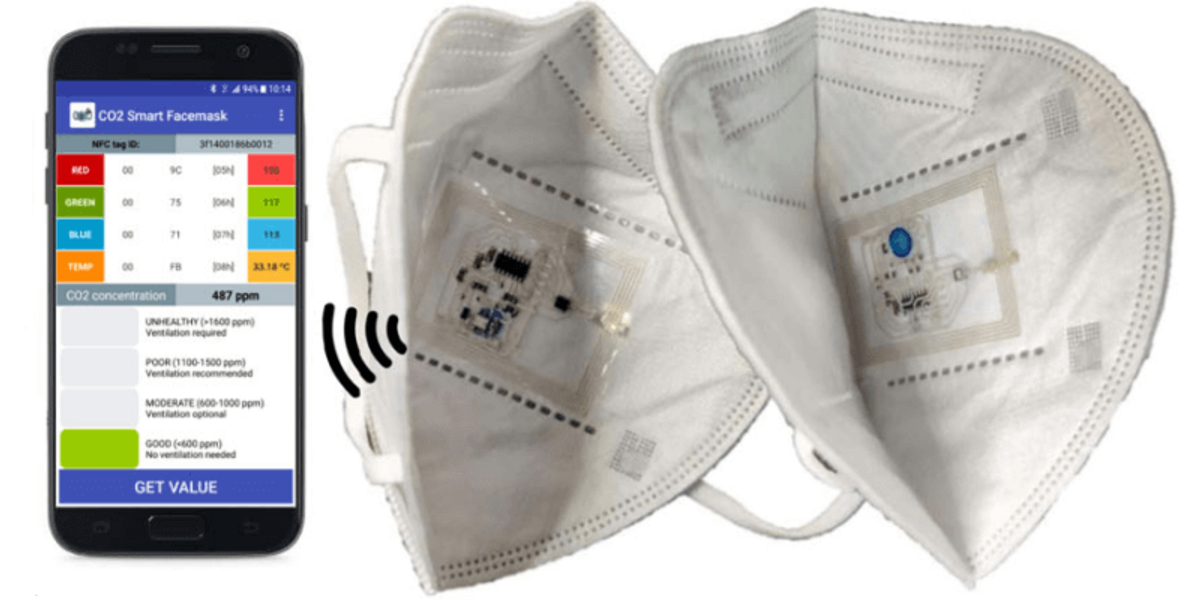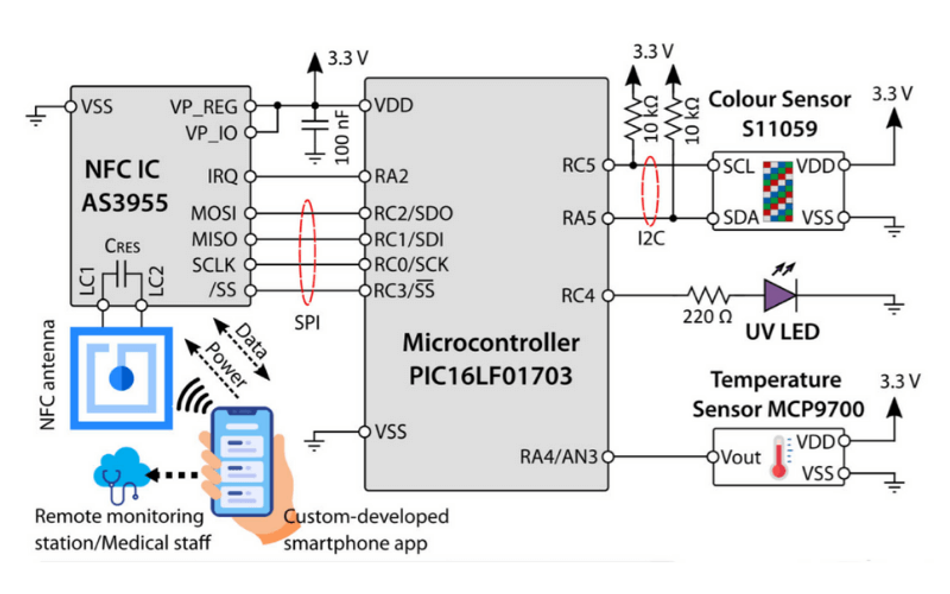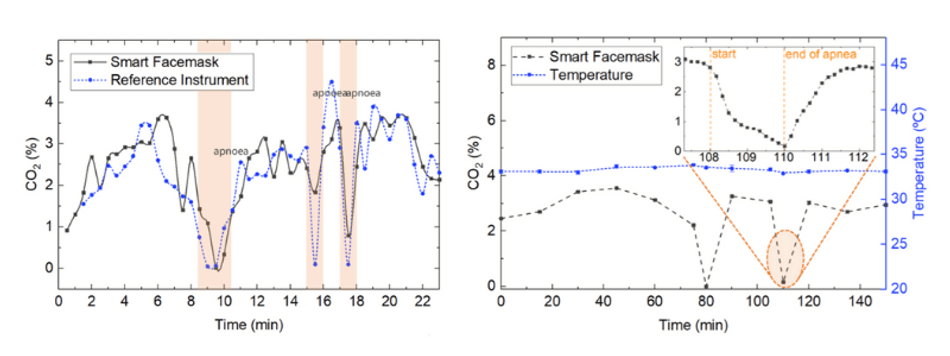Wearable and Intelligent Face Mask for CO2 monitoring

Smart Face Mask for CO2 monitoring through an opto-chemical sensor; results displayed on Smartphone application
A system with an opto-chemical sensor combined with a battery-free NFC tag of resolution 103 ppm for measuring the CO2 gas concentration in the dead space volume of the facemask
We have already covered a detailed article on the smart face mask platform integrating software and hardware to offer a user-friendly platform– that displays physiological signals [1]. With Covid-19 rising in several countries, face masks have become a part of day-to-day life– prolonged use of these face masks has adverse effects, primarily caused due to CO2 rebreathing. There have been reports concluding a significant drop in blood oxygen saturation and increase in heart and respiratory rate due to the increased CO2 concentration in the dead space volume (DSV). DSV is defined as the volume of ventilated air in which there is no significant gas exchange of oxygen and carbon dioxide.
The established mechanism to monitor the concentration or partial pressure of carbon dioxide in respiratory gases– capnography and other portable hardware to measure the gas inside the mask DSV have created complex issues for the required components and its bulky structure. Even though the proposed solutions are reliable with high resolution and accuracy, they are limited to laboratory experiments due to their size and power requirements. To solve the challenges in the space of wearability and conformability, utilizing the recent technological advancements and exploiting the developed research reports, a team of researchers, affiliated with the University of Granada, Spain, have proposed a system with wearable hardware that interacts with the custom smartphone application via a near-field communication link (NFC) [2].
NFC tag for Wireless CO2 readout
In the paper, “Smart facemask for wireless CO2 monitoring” the team has developed a system that consists of an opto-chemical sensor combined with a battery-free NFC tag with a resolution of 103 ppm for measuring the gas concentration in the DSV of the facemask. The sensor circuitry is fabricated in a tiny 60x45 mm2 sized polymeric substrate with the NFC link generated for the interaction with the custom-developed software application. The smartphone application is responsible for data processing, alert management, result displaying and sharing purposes. “Through performance tests during daily activity and exercise monitoring, we demonstrate its utility for non-invasive, wearable health assessment and its potential applicability for preclinical research and diagnostics,” the team explains in the research article.

While designing the portable hardware, the general design criteria were based on the IoT design flow– sensing, connectivity, compactness, integration, scalability, low-power consumption and affordability. Keeping all this into consideration, the proposed system with an NFC tag printed on a transparent flexible substrate is fixed on the inner part of the FFP2-type facemask. The goal is to read out the CO2 concentration through the deposited chemical sensor with the fluorescent response of which results will be wirelessly transferred onto the software applications. Based on stable inorganic phosphor, the opto-chemical CO2 sensor is the most essential hardware component in the whole hardware circuitry. Being an NFC-based system, the monitoring is completely passive with no requirement of battery– whereas the power supply is obtained from the near electromagnetic field induced by the external NFC reader (in this case the smartphone).
In the process for CO2 monitoring, the NFC tag has an attached ultraviolet light-emitting diode, which when powered on, the sensing substrate is active. The luminescence intensity is measured to determine the CO2 concentration through the red coordinate of the RGB color space. The incoming luminescence intensity is collected by the digital color detector then sent to the microcontroller unit. The final results will be sent to the mobile application for further processing.
Did performance prove its utility?
For evaluation purposes, the smart facemask was tested on short-term and long-term usage in static conditions. For the initial test case, the CO2 concentration was monitored every 30 seconds through the proposed smart face mask as well as a reference instrument such as MultiRAE Lite, RAE Systems. By comparing the results, the curves show to be in good agreement with close results. In the early stage of the monitoring, the face smart curve is slightly in a delayed fashion in comparison to the reference standard– this is because of the time required to fill the mask’s DSV. Three apnoeas can be seen when the holding of breath during the test was performed to see the varying results and accuracy.

For the long-term test, the face mask was worn for over 2.5 hours and the measurements were taken every 15 minutes. The monitoring is performed with temperature values into consideration to check the stability of the opto-chemical sensor. Two apnoeas at the stamp time of 80 and 110 minutes show a sharp drop in CO2 concentration. Overall, the CO2 accumulation for common conditions ranged from 1.5% to up to 3.5% which is well beyond the atmospheric air of approximately 0.04%. “Our results are in line with the reviewed literature, with CO2 values around 2% during low work-rate activities and peak values up to ~5% during high-intensity exercise,” the team notes.
In summary, the developed platform for CO2 monitoring with batteryless hardware structure enabling NFC-based wireless communication and scalable hardware fitted inside the FFP2 face mask makes the system versatile and robust for real-life deployment. For future work, the researchers expect to combine several optical chemical sensors that can be integrated into a single flexible passive NFC tag to monitor several gases' concentrations.
References
[1] Alexander Curtiss, Blaine Rothrock, Abu Bakar, Nivedita Arora, Jason Huang, Zachary Englhardt, Aaron-Patrick Empedrado, Chixiang Wang, Saad Ahmed, Yang Zhang, Nabil Alshurafa, and Josiah Hester. 2022. FaceBit: Smart Face Masks Platform. Proc. ACM Interact. Mob. Wearable Ubiquitous Technol. 5, 4, Article 151 (Dec 2021), 44 pages. DOI: https://doi.org/10.1145/3494991
[2] P. Escobedo, M. D. Fernández-Ramos, N. López-Ruiz, O. Moyano-Rodríguez, A. Martínez-Olmos, I. M. Pérez de Vargas-Sansalvador, M. A. Carvajal, L. F. Capitán-Vallvey, and A. J. Palma. Smart facemask for wireless CO2 monitoring. Nature Communication 13, Article 72 (Jan 2022). DOI: https://doi.org/10.1038/s41467-021-27733-3
